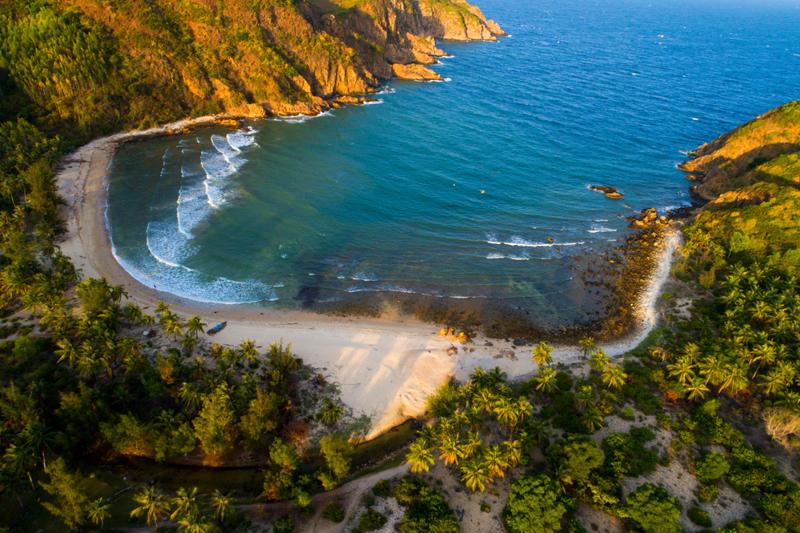With more than 3,260 km of coastline stretching from north to south and over 4,000 islands and reefs, Vietnam boasts countless stunning beaches, from the powdery white sands of Phu Quoc Island to the crystal-clear waters of Nha Trang. Yet, in the World’s 50 Best Beaches 2025 rankings, as voted on by more than 1,000 travel professionals, not a single Vietnamese beach made the cut. Meanwhile, neighboring countries like Thailand and the Philippines were proudly represented by names such as Bang Bao Beach and Entalula Beach.
This quiet omission has sparked more than curiosity; it has ignited a wave of reflection among Vietnam’s hoteliers, destination marketers, and tourism strategists on whether Vietnam’s beaches are simply under-recognized or if there are other reasons.
Hidden strength
While neighboring countries like Thailand, Indonesia, and the Philippines have successfully etched their coastlines into the hearts and Instagram feeds of global travelers, Vietnam’s story remains largely untold. And it’s not because the country lacks the beauty or the charm. “Vietnam, in terms of the quality of its beaches, is outstanding - absolutely on the same line as Malaysia, Thailand, and other countries,” said Mr. Martin Koerner, Group Commercial Director at The Anam. And yet, global travelers and rankings often overlook Vietnam’s coastline.
The issue, he continued, isn’t the product, it’s the packaging. Despite the country’s breathtaking coastal assets, Vietnam lacks a robust and consistent international tourism marketing presence.
Having just returned from ITB Berlin, the world’s largest travel trade fair, he highlighted a glaring gap: while other countries have teams abroad educating agents and tour operators, Vietnam does not. “Many destinations have offices in the UK, the US, Germany, or Switzerland,” he said. “They do events, they explain when to travel, what’s interesting, what the good beaches are. Vietnam doesn’t do that.”
This lack of presence abroad results in a branding vacuum that impacts traveler decision-making and market visibility. “Vietnam is still a lesser-known destination, especially when we look at Southeast Asia and the various beaches we are competing with, like in Bali, Thailand, and Boracay,” said Mr. Louis Walters, Managing Director of the Sailing Club Leisure Group. “They have fantastic recognition.”
But marketing isn’t the only hurdle. Mr. Walters also pointed to infrastructure challenges that impact the visitor experience. “Infrastructure in Vietnam, especially in beach destinations, is still relatively new,” he said. Taking Cam Ranh as an example, he said it’s going to be fantastic five years from now, maybe even sooner. But right now, while a number of resorts are open, many are still under construction.
Mr. Andre Pierre Gentzsch, Complex General Manager at Furama Resort Danang, added that the beaches in Vietnam are beautiful, “but we do not have distinctive beaches.” What’s needed, he emphasized, is creativity and curation from hoteliers and destination marketers.
Together, these voices underscore a shared belief: Vietnam’s beach tourism has all the natural ingredients to rival the best in the world, but unlocking that potential will require better branding, stronger infrastructure, and a more distinctive narrative.
Sustainability-first thinking
As Vietnam continues to expand its tourism footprint, sustainability and strategic planning are emerging not just as industry buzzwords but as critical pillars for long-term success. While destinations like Phu Quoc Island and Cam Ranh still face challenges in infrastructure and policy alignment, experts agree that the potential for meaningful transformation is immense.
For Mr. Adam Riley, Head of Hospitality at the BIM Group, Phu Quoc Island stands at a critical juncture. He has observed that when speaking to General Managers at top-tier hotels like the Regent, the InterContinental, and the Park Hyatt, “the first thing they say is it all comes back to sustainability.” This concern isn’t theoretical, it’s rooted in real customer expectations and operational priorities.
But realizing this vision requires more than ambition. It demands coordination between local authorities, owners, operators, and staff. He noted that the BIM Group is already exploring partnerships with organizations like The Ocean Cleanup to bring innovative, ocean-friendly waste solutions to the island, including technologies like the Interceptor - a floating system designed to remove plastic pollution from waterways.
This call for collective action was echoed by Mr. Manuel Ferriol Argent, General Manager at Melia Serenity Cam Ranh, who believes unlocking Vietnam’s full tourism potential starts with public sector leadership. “It all starts and ends for me with government and expenditure,” he said. “Without stronger investment in infrastructure, promotion, and policy frameworks, the private sector’s efforts risk stalling.” He also pointed out the urgency of government support in turning Cam Ranh’s scenic coastline into a globally-competitive destination.
Da Nang, meanwhile, offers a compelling example of what’s possible when development is pursued with strategic vision. According to Mr. Mario Mendis, General Manager of Fusion Resort & Villas Danang, the city has undergone a remarkable transformation over the past decade. Crucially, he emphasized the social sustainability behind that success.
Taken together, these insights suggest that Vietnam’s future in tourism lies not in overdevelopment, but in smart, sustainable strategies that integrate environmental responsibility, public-private collaboration, and long-term community value.
What the market really wants
Vietnam’s booming coastal hospitality sector is approaching a critical moment of reflection. As developers race to secure beachfront parcels, industry voices are asking an urgent question: Are we building what the market really wants? Do we need more places like Cam Ranh, with multiple hotel developments and long single strips of beaches? Or do we need more places like Mui Ne, with small hotels and quirky little F&B spots and more eclectic things along the beach?
Mr. Walters believes the answer lies in balance and segmentation. “I think there’s room in the market for both,” he said. “Cam Ranh, with its big hotels, massive inventory, and proximity to the airport, speaks to a more luxurious, upper-end market. Mui Ne, on the other hand, with smaller resorts and quirky F&B offerings, speaks more to expats and adventure seekers.”
This duality reflects Vietnam’s unique positioning in regional tourism. Destinations like Mui Ne are now just two and a half hours from Ho Chi Minh City thanks to expressway upgrades, giving rise to weekend escapes and lifestyle-driven tourism. Meanwhile, larger-scale developments in Cam Ranh are courting global travelers with multi-outlet resorts, spas, and children’s clubs.
But building for scale isn’t always the answer. Mr. Riley shared an interesting tale from Phu Quoc Island. “We were worried when a coastal road was built in front of our resort,” he remembered. “But it turned out to be the best thing to happen to us. The traffic and people coming through our property increased dramatically. Sometimes it’s the left-field decisions that have the biggest impact.”
Mr. Walters emphasized the importance of aligning product type with traveler, particularly when considering new frontiers like Quy Nhon and Phu Yen.
Still, some industry leaders urge restraint. “Can we finish what we started in Vietnam before looking elsewhere?” Mr. Argent asked. “Let’s perfect what we’ve got, and grow Phu Quoc Island correctly. Make Vietnam the place to go.”
Mr. Koerner echoed this long-view strategy. “We invested in Cam Ranh when it was still underdeveloped,” he said. “Now, with Fusion, JW Marriott, and others, it has grown into a proper destination. It takes time, but once the hotels are there, flights follow. First charter flights, then scheduled flights.”
What the market wants, then, isn’t one-size-fits-all. Travelers crave authenticity, variety, and accessibility. Developers must embrace that complexity, not only in design and amenities but also in master planning and timing.
As Vietnam opens new chapters in its coastal tourism, the winners will be those who listen closely, not just to the land or their spreadsheets but to the evolving voice of the market itself.









 Google translate
Google translate